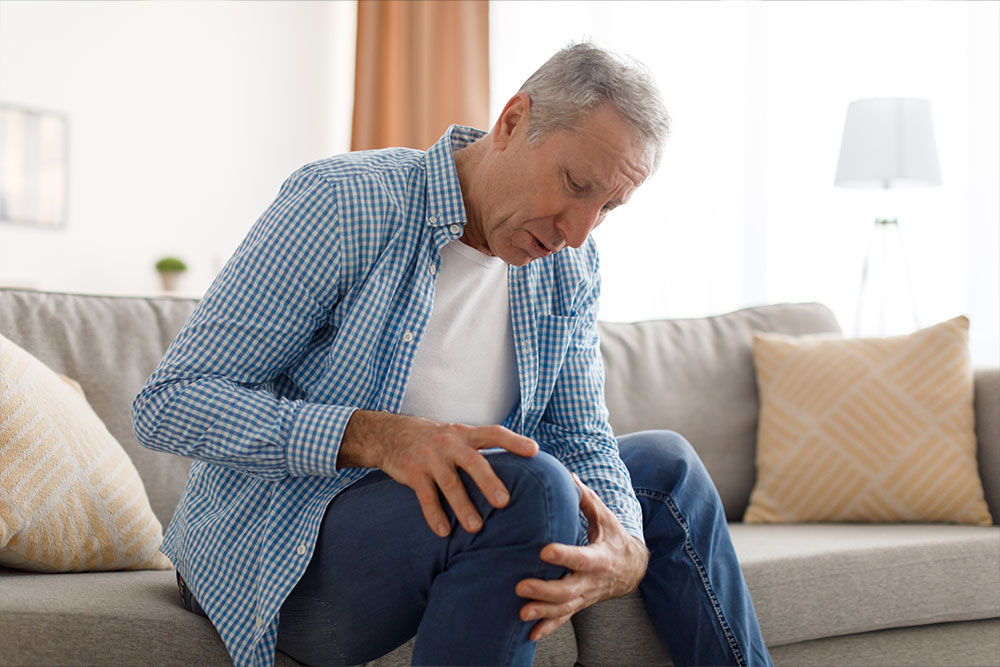The knee joint is one of the most mobile joints in your body, but it is also one of the likeliest to become stiff or painful when standing up after sitting. Knee stiffness can be related to issues with scar tissue, cartilage and overuse injuries.
If you experience knee stiffness after sitting, it can be helpful to pinpoint other symptoms you may be experiencing. Knowing the possible complications of your knee stiffness can help you find a treatment plan that helps relieve your knee pain.
5 causes of a stiff knee after sitting
About 1 in 4 U.S. adults suffer from chronic knee pain. This pain can be especially felt after sitting from long periods of time. Knee stiffness or tightness can affect people ranging from athletes to office workers. In fact, around 40% of all sports injuries are related to the knee joint.
Many reasons can be behind your knee feeling stiff after sitting. Those can include:
- Bursitis — Bursitis refers to the inflammation of a joint structure called the bursa. These are fluid-filled sacs that help reduce friction in the joints as they move, and there are several bursae in your knee joints. Overuse and strain are the most common reasons bursae become inflamed. Once this inflammation occurs, sitting for long periods of time can cause the knee to feel stiff. Rest is the most commonly recommended treatment for bursitis, but physical therapy can also be helpful for this issue.
- Osteoarthritis — There are several types of arthritis, and osteoarthritis is the most common form that can affect the knee. This form of arthritis is frequently caused by the natural wearing of cartilage in your knee as you age. With less cartilage, your knee joint moves with less cushioning between the bones and can become stiff. Stiffness can especially occur after sitting for a long period of time. Knee injuries can increase your chances of developing knee osteoarthritis. Studies show that physical therapy can be crucial to reducing osteoarthritis symptoms in the knee.
- Runner’s knee — Runner’s knee, or patellofemoral pain syndrome, refers to dull pain that radiates around the front of the knee. It is mostly caused by overuse during activities like running and jogging, but it can also be caused by weak thigh muscles, poor footwear and previous injuries. Sitting with your legs bent can irritate your knee’s already-inflamed tissue and lead to discomfort. You may also feel that your kneecap is tender to the touch.
- Inactivity — A sedentary lifestyle, or a lifestyle in which you perform minimal physical activity, can be hard on your joints. This is because inactivity leads to a lack of blood flow, tight tissue and stiff movement. It can also weaken the muscles around your knee joint so that your knee is less able to bear your weight comfortably, especially when getting up from a chair. By simply getting up and walking for a few minutes, you can help relieve your knee stiffness and pain. Doing so can be especially important if you are working behind a desk for hours at a time.
- Arthrofibrosis — Arthrofibrosis involves a buildup of scar tissue around a joint. It often occurs in the knee after surgery or injury. If you have arthrofibrosis, scar tissue may cause an inability to straighten or bend your leg all the way. You may also lose a significant amount of your knee’s range of motion. In addition, the condition can cause an immense amount of knee stiffness that can make getting in and out of a chair difficult. Physical therapy exercises and hands-on soft tissue mobilization sessions can help break up built-up scar tissue and help you regain range of motion.
When do you need to see a medical professional for your stiff knee after sitting?
It is important that you speak to your doctor as soon as you can about your knee stiffness, especially if it is a result of a recent injury. Doing so can help prevent further injury, limit further development of your condition and fast-track your healing process.
If you consistently experience knee stiffness after sitting, your doctor may prescribe physical therapy to help ease your knee stiffness. Physical therapists may recommend a variety of techniques and routines based on:
- How much pain you have.
- How old you are.
- Your overall health and health history.
- How long you have experienced symptoms.
- Your concerns and preferences.
- X-ray and other imaging results.
Alliance PTP can help you find relief from a stiff knee after sitting
Are you ready to find effective treatment for your knee stiffness? Our team of experts at Alliance PTP can help you. We offer a network of professional specialists who can help you understand the source of your knee stiffness and build a personalized therapy plan to target this source. Our plans are built using multiple beneficial therapy techniques, and some of the techniques we may use can include:
- Joint mobilization.
- Soft tissue mobilization.
- Active Release Techniques®.
- Dry needling.
- At-home care.
- Vritual Physical Therapy.
Take the next step in treating your knee stiffness by locating one of our physical therapy clinics near you. In addition, you can contact our team today for more information or to schedule an initial appointment.
*Note: This article is a revision of one originally posted by an Alliance Physical Therapy partner.

